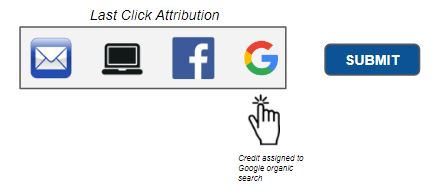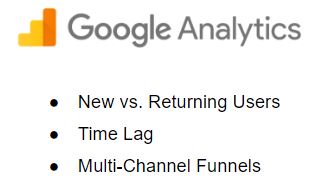Attribution is the model used for measuring marketing results that determines which channel gets credit for actions that take place on your website.
For instance, suppose you have a “contact us” form on your website and you are running paid search, display, organic search, and email campaigns to promote your services. When a user finally enters their information into your contact form and clicks the “submit” button, it is your attribution model that decides which of those campaigns was responsible for getting that user to convert.

This is important because the marketing campaigns that get the credit end up receiving additional investment. It’s logical that you would invest more money into campaigns that are more effective, up until the point of diminishing returns.
Historically, many marketers have used only one attribution model to govern how credit was given. This model, known as “last click,” assigns all of the credit to the marketing channel that brought the user to your website immediately before they converted. In some cases this might be appropriate, but it is becoming increasingly common that users arrive at websites through multiple channels and interact with them multiple times before taking action.
When thinking about your digital marketing, you want to know that tracking is set up correctly, that there aren’t any ways that users are taking action that you aren’t measuring, and that credit is being assigned correctly.
If you aren’t confident that all of the above are correct, now is a good time to ask your marketing team for a review of your situation in order to ensure marketing remains a channel for growth in your business.

Technology has provided a handful of alternative attribution models which have evolved to assign credit in more sophisticated ways.
By taking more than one factor into account, your campaigns can be better optimized for greater returns, which can be re-invested and generate even more revenue over the long-term.
Here are the key considerations to use when choosing the most appropriate attribution model:

Past website visitation: Is this a new or returning user? If they have been to your website before, how much did you spend to acquire them originally, and to bring them back a 2nd, 3rd, 4th, or 15th time? If your business does not have a CRM solution, Google Analytics allows you to make some distinctions, but anonymous User-ID tracking requires additional development to setup.
Average Number of Days to Conversion: Are users converting on your website immediately in most cases, or does it take many days and interactions before they commit to action? You can use the time lag report in Google Analytics to get a feel for this on a high level. This report should also influence your audience measurement and analytics settings (including the “conversion window”). If your conversion window is set to the 30-day default, but it typically takes a customer 90 days to buy your product, then your time lag report is wrong!
Average Number of Paths to Conversion: Are there many different ways that people can find your website? The answer, most definitely, is yes! If users visit 2 or more times before converting, then a discussion should be had about how valuable each touchpoint along the way is. If you want to study the number of paths and the channels themselves, visit the multi-channel funnels report in Google Analytics.
Later this year, Google will be releasing its Google Attribution tool and attribution will again surface as a hot topic.
If you want to be proactive, prioritize a discussion with your marketing team about how credit is being assigned to campaigns in order to create clarity in your organization about your business goals and how marketing is contributing to them.
If you need help to facilitate this conversation or to have a review of your data and a recommendation of which model is most appropriate for your situation, please contact us.





















